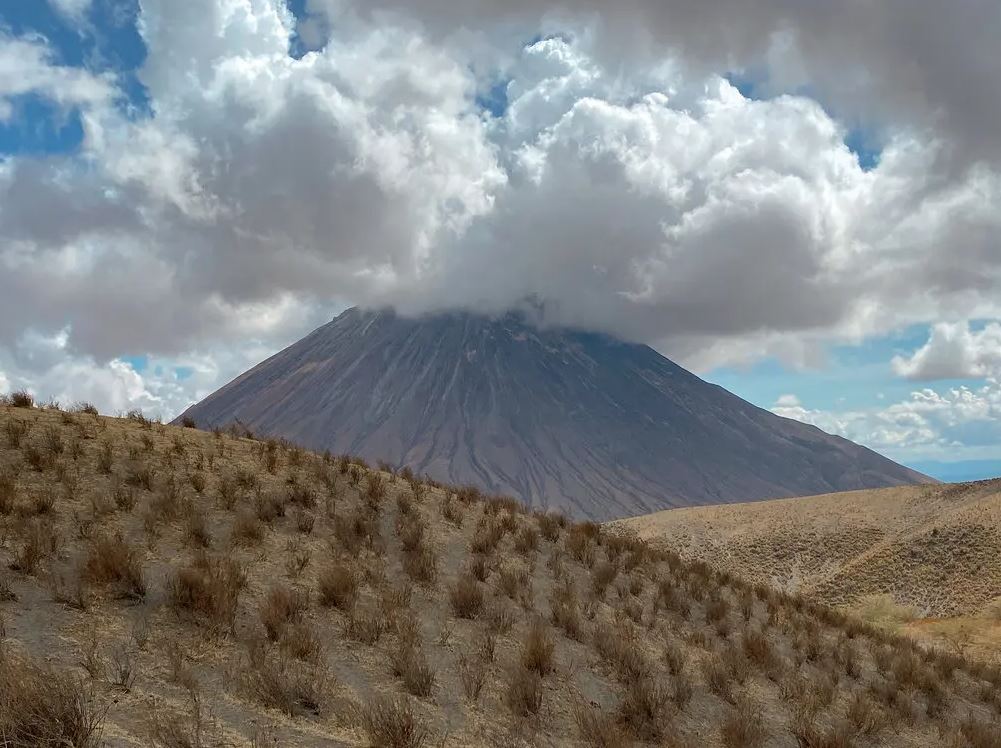The muted booms pierced the calm as we lay on a slope of pulverised lava beads in a narrow cave on the peak of a volcano in East Africa, about two miles up into the night sky. They sounded like distant explosions or rumbling thunderclouds.
It was five in the morning, and we had been climbing the enormous pyramid-shaped Ol Doinyo Lengai for the previous six hours. We had passed through waist-high tufts of grass covered in powdered ash, through loose rock and narrow cracks, and eventually through solidified lava flows that were so steep that I had to walk on all fours. Now when we were fatigued, we were resting inside of a fissure that had walls the colour of chalk. We began our ascent onto the rim of the crater fifteen minutes before daybreak and continued until we reached the top.
Our arduous and incredible trek across the Crater Highlands of Tanzania had been going on for a week, and we were getting closer and closer to the expedition’s breathtaking culmination. The region sprawls along the East African Rift, which is an area where magma was able to rise millions of years ago due to the separation of tectonic plates. This resulted in the eruption of a plethora of volcanoes over the course of many millennia, many of which have now collapsed and become dormant peaks or calderas.
Kilimanjaro, which is located around 100 miles to the east and has an elevation of 19,340 feet, is the most well-known of the mountains. Kaixu wanted companionship on the trip she had booked from New York, even though she had no concrete plans. Because I’m not a huge lover of the cold or the lack of oxygen, I looked for an alternate kind of adventure.
I sent out requests for guides on Instagram, and a relatively new tour operator called Daudi Minde was the one that I decided to go with. We came to an agreement on a tour that would cost $1,750 per person and would consist of two nights spent camping, a 10-hour hike, and four nights spent in hotels and lodges.
Luxury safaris, complete with fully-furnished tents and hot air balloon excursions over the Serengeti, were nothing like our trip at all. Daudi put planned a tour for us that consisted of using independent guides, borrowing an ancient Land Cruiser, and staying in facilities with little frills in order to take us to locations that we most likely would not have discovered without the assistance of local experts.
Our guide, Aidano Kayala, and our chef, Ramadhan Singano, began loading the Land Cruiser at 6:30 in the morning with all of the necessary camping equipment. As we travelled west, we passed run-down storefronts, people roasting corn on the side of the road, and lines of young guys waiting for fares on their motorbikes with chrome-fronted helmets.
At the entrance to the Ngorongoro Conservation Area, where, in contrast to Tanzanian national parks, the Maasai are allowed to develop homes and graze animals, broken rocks were being used to rebuild the steep dirt road. The Maasai have been living in the area for centuries. Aidano sped by as two Land Cruisers were perched on their roofs and immobilised at an angle of 45 degrees.
Even though there was an increase in wind speed, the temperature remained in the upper 50s. The almost full moon was difficult to make out because of the thick blanket of clouds. The dry stone became covered in tiny dark stains as a rain passed across it. The ascent was becoming more difficult. The ground was composed of a combination of loose stones and sand that was so deep that with each step forward we fell back several inches.
Just as the light was about to peek over the horizon close to Kilimanjaro, we struggled up to the rim of the mountain. We were subjected to a blustery environment in which we peered down about 20 storeys into a mesmerizingly magnificent maelstrom of rising steam and spewing lava.
The diameter of the crater was about 200 yards, and it was surrounded by brownish-stratified cliffs that encircled a moonscape that had jagged rocks and hornitos in a variety of hues of grey and white. Vents located all around the circular produced rising columns of gas. A profusion of huge cones with jagged holes at the summits loomed in the centre of the area, which was flanked on all sides by arabesque plains that gave the appearance of crusted lakes. When the wind dropped down, we could hear the lava churning and spitting like some kind of seething monster from the underworld. The biggest one was smooth and grey. A shower of black beads would erupt from the hornito about once per minute or two, and they would roll down the sides.
I went for a brisk jog around the rim, pausing sometimes to reflect on the molten force that formed these highlands and wishing for an eruption that would not be lethal but would be significant. But after approximately an hour, it was time to begin the precarious drop that would last for six hours. As the sun began to rise, it warmed the slopes of the lava flow that had been entombed, spreading a pyramid shadow over the countryside far below.

